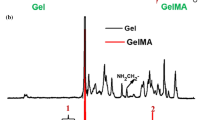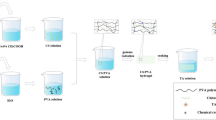Abstract
Fabricating robust and multi-functional hydrogels is of great importance and challenge. In this work, chitosan (CS) and polyvinyl alcohol (PVA) were used to design antiseptic, conductive and robust hydrogels by a two-step method. Chemical structures of gels, the degree of crystallinity, the state of water in hydrogels, as well as their microstructures were characterized via a combination of FT-IR, XRD, DSC and SEM. Segment lengths of cross-linking points were calculated from elastic rubber theory. Their mechanical properties were evaluated on the electronic testing machine. It was shown that the tensile strength and elongation at break of single PVA hydrogel were only 200 kPa and 135%, respectively, due to the heterogenous structure with pore sizes between 1.5 ~ 8.2 μm. By introducing CS into PVA matrix followed with soaking in a saturated NaCl solution, the network became homogeneous with a pore size of 0.5 ~ 1.1 μm. Moreover, free water changed to bond water, and frictions between polymer chains increased because of hydrophobic associations and entanglements of CS segments. As a result, the tensile stress and strain increased to 3800 kPa and 270%, respectively. The gel also exhibited antiseptic property, electrical conductivity and swelling-resistant properties. The strength after reaching swell equilibrium was 3400 kPa, much higher than most gels at swollen states. This gel might find applications in bionic cartilage, sensors, food preservation and wearable devices.








Similar content being viewed by others

References
Li J, Mo LT, Lu CH, Fu T, Yang HH, Tan WH (2016) Functional nucleic acid-based hydrogels for bioanalytical and biomedical applications. Chem Soc Rev 45(5):1410–1431
Thiele J, Ma Y, Bruekers SMC, Ma SH, Huck WTS (2014) 25th anniversary article: designer hydrogels for cell cultures: a materials selection guide. Adv Mater 26(1):125–148
Wang HY, Heilshorn SC (2015) Adaptable hydrogel networks with reversible linkages for tissue engineering. Adv Mater 27(25):3717–3736
An H, Chang LM, Shen JF, Zhao SH, Zhao MY, Wang XM, Qin JL (2019) Light emitting self-healable hydrogel with bio-degradability prepared form pectin and Tetraphenylethylene bearing polymer. J Polym Res 26(2):26
Gong JP (2010) Why are double network hydrogels so tough? Soft Matter 6(12):2583–2590
Gong JP, Katsuyama Y, Kurokawa T, Osada Y (2003) Double-network hydrogels with extremely high mechanical strength. Adv Mater 15(14):1155–1158
Haraguchi K, Takehisa T (2002) Nanocomposite hydrogels: a unique organic-inorganic network structure with extraordinary mechanical, optical, and swelling/de-swelling properties. Adv Mater 14(6):1120–1124
Huang T, Xu HG, Jiao KX, Zhu LP, Brown HR, Wang HL (2007) A novel hydrogel with high mechanical strength: a macromolecular microsphere composite hydrogel. Adv Mater 19(12):1622–1626
Okumura Y, Ito K (2001) The Polyrotaxane gel: a topological gel by figure-of-eight cross-links. Adv Mater 13(7):485–487
Chen F, Lu SP, Zhu L, Tang ZQ, Wang QL, Gang Q, Yang J, Sun GZ, Zhang Q, Chen Q (2019) Conductive regenerated silk fibroin-based hydrogels with integrated high mechanical performances. J Mater Chem B 7(10):1708–1715
Chen Q, Zhu L, Chen H, Yan HL, Huang LN, Yang J, Zheng J (2015) A novel design strategy for fully physically linked double network hydrogels with tough, fatigue resistant, and self-healing properties. Adv Funct Mater 25(10):1598–1607
Duan JJ, Zhang LN (2017) Robust and smart hydrogels based on natural polymers. Chin J Polym Sci 35(10):1165–1180
Guo FY, Wang N, Cheng QF, Hou LL, Liu JC, Yu YL, Zhao Y (2016) Low-cost coir Fiber composite with integrated strength and toughness. ACS Sustain Chem Eng 4(10):5450–5455
Ghasemzadeh H, Ghanaat F (2012) Antimicrobial alginate/PVA silver nanocomposite hydrogel, synthesis and characterization. J Polym Res 21(3):355
Sun JY, Zhao XH, Illeperuma WRK, Chaudhuri O, Oh KH, Mooney DJ, Vlassak JJ, Suo ZG (2012) Highly stretchable and tough hydrogels. Nature 489(7414):133–136
Yang W, Fortunati E, Bertoglio F, Owczarek JS, Bruni G, Kozanecki M, Kenny JM, Torre L, Visai L, Puglia D (2018) Polyvinyl alcohol/chitosan hydrogels with enhanced antioxidant and antibacterial properties induced by lignin nanoparticles. Carbohydr Polym 181:275–284
Luo CH, Sun XX, Wang F, Wei N, Luo FL (2019) Utilization of L-serinyl derivate to preparing triple stimuli-responsive hydrogels for controlled drug delivery. J Polym Res 26:280
Kobayashi M, Toguchida J, Oka M (2003) Preliminary study of polyvinyl alcohol-hydrogel (PVA-H) artificial meniscus. Biomaterials 24(4):639–647
Ghasemzadeh H, Ghanaat F (2014) Antimicrobial alginate/PVA silver nanocomposite hydrogel, synthesis and characterization. J Polym Res 21(3):355
Hassan CM, Peppas NA (2000) Structure and applications of poly(vinyl alcohol) hydrogels Producd by conventional crosslinking or by freezing/thawing methods. Adv Polym Sci 153:37–65
Ricciardi R, D'Errico G, Auriemma F, Ducouret G, Tedeschi AM, Rosa CD, Lauprêtre F, Lafuma F (2005) Short time dynamics of solvent molecules and Supramolecular Organization of Poly (vinyl alcohol) hydrogels obtained by freeze/thaw techniques. Macromolecules 38(15):6629–6639
Baker MI, Walsh SP, Schwartz Z, Boyan BD (2012) A review of polyvinyl alcohol and its uses in cartilage and orthopedic applications. J Biomed Mater Res B Appl Biomater 100(5):1451–1457
Chen Q, Zhu L, Zhao C, Wang QM, Zheng J (2013) A robust, one-pot synthesis of highly mechanical and recoverable double network hydrogels using thermoreversible sol-gel polysaccharide. Adv Mater 25(30):4171–4176
Zhang HJ, Sun TL, Zhang AK, Ikura Y, Nakajima T, Nonoyama T, Kurokawa T, Ito O, Ishitobi H, Gong JP (2016) Tough physical double-network hydrogels based on Amphiphilic Triblock copolymers. Adv Mater 28(24):4884–4890
Yang YY, Wang X, Yang F, Wang LN, Wu DC (2018) Highly elastic and ultratough hybrid ionic-covalent hydrogels with tunable structures and mechanics. Adv Mater 30(18):e1707071
Fan HL, Wang JH, Jin ZX (2018) Tough, swelling-resistant, self-healing, and adhesive dual-cross-linked hydrogels based on polymer–tannic acid multiple hydrogen bonds. Macromolecules 51(5):1696–1705
Cipriano BH, Banik SJ, Sharma R, Rumore D, Hwang W, Briber RM, Raghavan SR (2014) Superabsorbent hydrogels that are robust and highly stretchable. Macromolecules 47(13):4445–4452
Cheng Y, Gray KM, David L, Royaud I, Payne GF, Rubloff GW (2012) Characterization of the cathodic electrodeposition of semicrystalline chitosan hydrogel. Mater Lett 87:97–100
Rodrigues FHA, Fajardo AR, Pereira AGB, Ricardo NMPS, Feitosa JPA, Muniz EC (2012) Chitosan-graft-poly(acrylic acid)/rice husk ash based superabsorbent hydrogel composite: preparation and characterization. J Polym Res 19(12):1
Ladet SG, Tahiri K, Montembault AS, Domard AJ, Corvol MTM (2011) Multi-membrane chitosan hydrogels as chondrocytic cell bioreactors. Biomaterials 32(23):5354–5364
Treenate P, Monvisade P, Yamaguchi M (2014) Development of hydroxyethylacryl chitosan/alginate hydrogel films for biomedical application. J Polym Res 21(12):601
Kurdtabar M, Koutenaee RN, Bardajee GR (2018) Synthesis and characterization of a novel pH-responsive nanocomposite hydrogel based on chitosan for targeted drug release. J Polym Res 25(5):119
Wang T, Gunasekaran S (2006) State of water in chitosan–PVA hydrogel. J Appl Polym Sci 101(5):3227–3232
Zhang L, Zhao J, Zhu JT, He CC, Wang HL (2012) Anisotropic tough poly(vinyl alcohol) hydrogels. Soft Matter 8(40):10439–10447
Sun XX, Luo CH, Luo FL (2020) Preparation and properties of self-healable and conductive PVA-agar hydrogel with ultra-high mechanical strength. Eur Polym J (124):109465
He QY, Huang Y, Wang SY (2018) Hofmeister effect-assisted one step fabrication of ductile and strong gelatin hydrogels. Adv Funct Mater 28(5):1705069
Tobolsky AV, Carlson DW, Indictor N (1961) Rubber elasticity and chain configuration. J Polym Sci Polym Chem 54(159):175–192
Jiang GQ, Liu C, Liu XL, Chen QR, Zhang GH, Yang M, Liu FQ (2010) Network structure and compositional effects on tensile mechanical properties of hydrophobic association hydrogels with high mechanical strength. Polymer 51(6):1507–1515
Wang LY, Wang MJ (2016) Removal of heavy metal ions by poly(vinyl alcohol) and Carboxymethyl cellulose composite hydrogels prepared by a freeze–thaw method. ACS Sustain Chem Eng 4:2830–2837
Niknia N, Kadkhodaee R (2017) Factors affecting microstructure, physicochemical and textural properties of a novel gum tragacanth-PVA blend cryogel. Carbohydr Polym 155:475–482
Hu J, Kurokawa T, Hiwatashi K, Nakajima T, Wu ZL, Liang SM, Gong JP (2012) Structure optimization and mechanical model for microgel-reinforced hydrogels with high strength and toughness. Macromolecules 45:5218–5228
Jiang XC, Xiang NP, Zhang HX, Sun YJ, Lin Z, Hou LX (2018) Preparation and characterization of poly(vinyl alcohol)/sodium alginate hydrogel with high toughness and electric conductivity. Carbohydr Polym 186:377–383
Thanyacharoen T, Chuysinuanb P, Techasakul S, Nooeaid P, Ummartyotina S (2018) Development of a gallic acid-loaded chitosan and polyvinyl alcohol hydrogel composite: release characteristics and antioxidant activity. Int J Biol Macromol 107(Pt A):363–370
Fan LH, Yang H, Yang J, Peng M, Hu J (2016) Preparation and characterization of chitosan/gelatin/PVA hydrogel for wound dressings. Carbohydr Polym 146:427–434
Pretsch E, Bühlmann P, Badertscher M (2000) Structure determination of organic compounds. Springer-Verlag, Berlin
Flory PJ (1953) Principles of polymer chemistry. Cornell University Press, Ithaca
Wang L, Jian YK, Le XX, Lu W, Ma CX, Zhang JW, Huang YJ, Huang CF, Chen T (2018) Actuating and memorizing bilayer hydrogels for a self-deformed shape memory function. Chem Commun (Camb) 54(10):1229–1232
Lin P, Ma SH, Wang XL, Zhou F (2015) Molecularly engineered dual-crosslinked hydrogel with ultrahigh mechanical strength, toughness, and good self-recovery. Adv Mater 27(12):2054–2059
Bai RB, Yang JW, Suo ZG (2019) Fatigue of hydrogels. Eur J Mech A-Solid 74:337–370
Wang YJ, Zhang XN, Song YH, Zhao YP, Chen L, Su FM, Li LB, Wu ZL, Zheng Q (2019) Ultrastiff and tough Supramolecular hydrogels with a dense and robust hydrogen bond network. Chem Mater 31(4):1430–1440
Wang R, Wang Q, Li L (2003) Evaporation behaviour of water and its plasticizing effect in modified poly(vinyl alcohol) systems. Polym Int 52(12):1820–1826
Zhou XY, Zhao F, Guo YH, Rosenberger B, Yu GH (2019) Architecting highly hydratable polymer networks to tune the water state for solar water purification. Sci Adv 5:eaaw5484
Trieu HH, Qutubuddin S (1994) Polyvinyl alcohol hydrogels I. Microscopic structure by freeze-etching and critical point drying techniques. Colloid Polym Sci 272(3):301–309
Luo CH, Wei N, Sun XX, Luo FL (2020) Fabrication of self-healable, conductive, and ultra-strong hydrogel from polyvinyl alcohol and grape seed–extracted polymer. J Appl Polym Sci 137:e49118
Gurses MS, Erkey C, Kizilel S, Uzun A (2017) Characterization of sodium Tripolyphosphate and sodium citrate dehydrate residues on surfaces. Talanta 176:8
Kupiec TC, Goldenring JM, Vishnu R (2004) A non-fatal case of sodium toxicity. J Anal Toxicol 6:6
Acknowledgements
This work was supported by the Specialized Research Fund in Ningxia Higher Education Institutions (NGY2018-165), Natural Science Foundation of Ningxia Province (2020AAC03205), and Natural Science Foundation of China (21464001).
Author information
Authors and Affiliations
Corresponding authors
Ethics declarations
Competing interest
The authors declare no competing financial interest.
Additional information
Publisher’s note
Springer Nature remains neutral with regard to jurisdictional claims in published maps and institutional affiliations.
Electronic supplementary material
ESM 1
(PNG 1447 kb)
Rights and permissions
About this article
Cite this article
Luo, C., Zhao, Y., Sun, X. et al. Fabrication of antiseptic, conductive and robust polyvinyl alcohol/chitosan composite hydrogels. J Polym Res 27, 269 (2020). https://doi.org/10.1007/s10965-020-02247-6
Received:
Accepted:
Published:
DOI: https://doi.org/10.1007/s10965-020-02247-6



